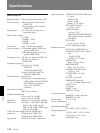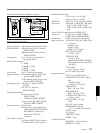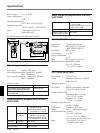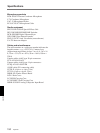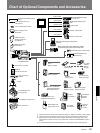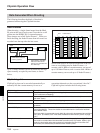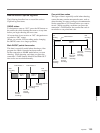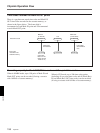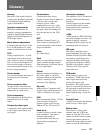
Appendix 157
Appendix
Aliasing
Distortion of the signal caused by
overlap of the baseband signal and
lower sideband signal when the
signal is demodulated.
Aperture compensation
Electronic compensation for
frequency response degradations
caused to sampled high-frequency
signals by the limited aperture of
CCD image sensors.
Black balance adjustment
To balance the black levels of the
R, G, and B channels of a video
camera so that black has no color.
CCD
Charge-coupled device. A solid
state imager used in most recent
video cameras in place of a pickup
tube. It converts input light levels
into electrical charges, which are
once stored and then output in the
form of voltage variations.
Center marker
A cross that indicates the center of
the image on the viewfinder
screen.
Color conversion filter
An optical filter used with color
video cameras to convert the color
temperature of a light source.
Color temperature
The temperature in Kelvins (K) to
represent the color of a light
source.
Composite video signal
A composite video signal includes
a video signal, burst signal, and
sync signal.
Glossary
Condensation
Condensation refers to tiny
droplets of water that can appear in
a device, such as in the tape
transport system. When
condensation occurs on a video
head drum, the tape may stick to
the drum, which can damage not
only the tape but also the VCR
unit.
DCC
Dynamic Contrast Control. A
video camera containing a DCC
circuit can handle a wide dynamic
range of luminance.
Drum
See “Head drum”.
Flare
Dark or colored flashes caused by
signal overload through extreme
light reflections of polished objects
or very bright lights.
Flicker
Repeated change of brightness on
the screen, which is caused by
frequency difference between the
camera’s scanning and the
variations in the lightning.
Gen-lock
Abbreviation of “generator lock”.
It refers to the synchronization of a
VCR to a reference sync signal.
HAD
Hole-Accumulated Diode. A CCD
sensor structure designed to
suppress certain types of noise
inherent CCDs. See also CCD.
Head drum
A metal cylinder to which a video
head is attached. This drum is
rotated at high speeds in
synchronization with the sync
signal during recording and
playback.
Horizontal resolution
The capability of a CCD camera to
preserve detail in the horizontal
resolution.
Usually expressed as the number
of vertical lines which can be
distinguished in the reproduced
image of a test chart.
i.LINK
i.LINK stands for IEEE1394-1995
stan-dards and their revisions. It is
applied to the DV connector
through which DV signals can be
transmitted with AV protocol.
IRE scale
The scale to determine video
signal amplitudes devised by the
Institute of Radio Engineers (IRE),
an American organization now
called the Institute of Electrical
and Electronic Engineers (IEEE).
The IRE scale includes a total of
140 units, with 100 up and 40
down from zero.
PCM audio
PCM stands for “pulse code
modulation.” PCM audio means
audio signals that have been
processed by pulse code
modulation. Each analog audio
signal is converted into pulses that
are generated in rapid succession,
and each pulse is recorded as a
digital signal having a value of 0
or 1.
Pedestal level
A black level which is the absolute
black level of a video signal.
Return video
This refers to a video signal
returned from the VCR to the
camera or from the CCU to one
camera in a multi-camera system,
allowing the camera operator to
monitor the image output from the
camera or shot on other cameras.




